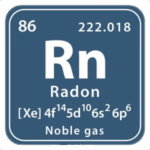The Invisible Threat Beneath Our Feet: Why Real-Time Radon Monitoring Matters in High-Radon Areas
Radon is a naturally occurring radioactive gas that forms from the decay of uranium in soil, rock, and groundwater. Odourless, colourless, and tasteless, it’s impossible to detect without specialist equipment—yet it is the second leading cause of lung cancer after smoking.

In areas with high geological concentrations of uranium, radon can seep through building foundations and accumulate indoors—in homes, schools, and workplaces. Many people living in these regions remain unaware of the ongoing exposure they may face.
The Case for Real-Time Monitoring
Traditional radon testing methods typically involve passive detectors that collect data over a set period—often several weeks or even months. While these tests are useful for establishing a baseline exposure level, they fall short in providing timely, actionable insights. This is where real-time radon monitoring with modern sensors proves invaluable.
Real-time radon monitoring systems use advanced digital sensors to continuously track radon levels, providing live data and alerts when thresholds are exceeded. These systems are especially critical in high-radon areas, where levels can fluctuate daily due to changes in weather, ventilation, or building use.
Key Benefits of Real-Time Radon Monitoring
1. Immediate Risk Awareness
Continuous monitoring enables the immediate detection of elevated radon levels, allowing for prompt action to reduce exposure. This is particularly important in homes with vulnerable individuals, such as children, the elderly, or those with respiratory conditions.
2. Data-Driven Mitigation
Real-time data allows property owners and facilities managers to make informed decisions about mitigation measures, such as improving ventilation or sealing entry points. Over time, monitoring also helps verify the effectiveness of these interventions.
3. Long-Term Safety Assurance
Unlike one-off passive tests, real-time systems provide ongoing peace of mind. This is valuable for homeowners, tenants, schools, and employers seeking to maintain healthy indoor environments year-round.
4. Smart Integration & Alerts
Many modern radon sensors integrate with smart home systems or cloud platforms, sending instant alerts via text, email, or mobile app. This connectivity ensures no dangerous rise in radon levels goes unnoticed.
A Public Health Priority in High-Radon Areas
High-radon areas are well-mapped across the UK. The UK Health Security Agency (UKHSA, formerly Public Health England) provides a detailed radon map that shows the estimated percentage of homes above the action level in each postcode area.
In these designated zones, it is strongly recommended to carry out radon testing—especially during property transactions or in new buildings. However, proactive, ongoing monitoring is not yet mandatory in most situations.
Given radon’s hidden dangers and potentially fatal consequences, it’s time for that to change.
Conclusion: Awareness Isn’t Enough—Action is Essential
The science is clear: radon exposure is a serious health risk. In high-radon areas, relying on occasional testing is no longer sufficient. Real-time monitoring offers a safer, smarter, and more proactive way to manage radon exposure.
Whether you’re a homeowner, landlord, school administrator, or facilities manager, investing in real-time radon monitoring is a small step that could make a life-saving difference. Don’t wait until it’s too late—monitor, mitigate, and protect.

